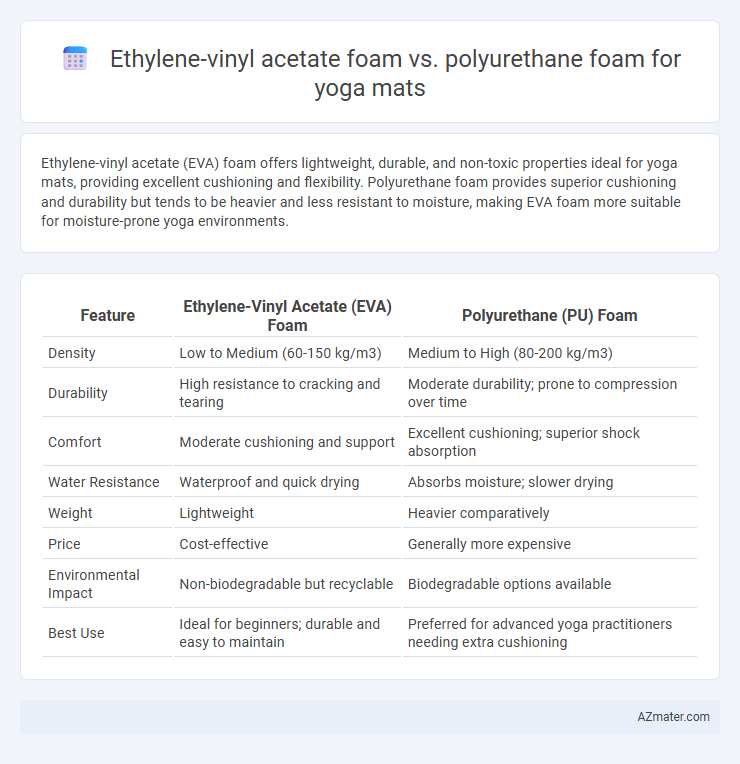Ethylene-vinyl acetate (EVA) foam offers lightweight, durable, and non-toxic properties ideal for yoga mats, providing excellent cushioning and flexibility. Polyurethane foam provides superior cushioning and durability but tends to be heavier and less resistant to moisture, making EVA foam more suitable for moisture-prone yoga environments.
Table of Comparison
| Feature | Ethylene-Vinyl Acetate (EVA) Foam | Polyurethane (PU) Foam |
|---|---|---|
| Density | Low to Medium (60-150 kg/m3) | Medium to High (80-200 kg/m3) |
| Durability | High resistance to cracking and tearing | Moderate durability; prone to compression over time |
| Comfort | Moderate cushioning and support | Excellent cushioning; superior shock absorption |
| Water Resistance | Waterproof and quick drying | Absorbs moisture; slower drying |
| Weight | Lightweight | Heavier comparatively |
| Price | Cost-effective | Generally more expensive |
| Environmental Impact | Non-biodegradable but recyclable | Biodegradable options available |
| Best Use | Ideal for beginners; durable and easy to maintain | Preferred for advanced yoga practitioners needing extra cushioning |
Introduction to Yoga Mat Materials
Ethylene-vinyl acetate (EVA) foam and polyurethane (PU) foam are common materials used in yoga mats, each offering distinct benefits. EVA foam provides lightweight, durable, and impact-absorbing properties ideal for cushioning and support during yoga practice. PU foam delivers superior elasticity and moisture resistance, enhancing grip and comfort on various surfaces.
Overview of Ethylene-vinyl Acetate (EVA) Foam
Ethylene-vinyl acetate (EVA) foam is a closed-cell material known for its excellent cushioning, flexibility, and shock absorption, making it ideal for yoga mats. Its lightweight nature and resistance to water and UV rays enhance durability and comfort during practice. EVA foam also provides good traction and resilience, offering a balance between softness and support preferred by yoga practitioners.
Overview of Polyurethane (PU) Foam
Polyurethane (PU) foam exhibits high elasticity, excellent durability, and superior cushioning, making it a preferred choice for high-quality yoga mats. Its open-cell structure provides good breathability and moisture resistance, enhancing comfort during extended practice sessions. PU foam also offers better resilience and support compared to Ethylene-vinyl acetate (EVA) foam, contributing to enhanced joint protection and overall performance.
Cushioning and Support Comparison
Ethylene-vinyl acetate (EVA) foam provides a lightweight, durable cushioning with excellent shock absorption, making it ideal for low-impact yoga practices requiring firm support. Polyurethane (PU) foam offers superior density and resilience, delivering enhanced support and comfort for prolonged sessions or styles involving significant joint pressure. EVA foam's closed-cell structure prevents moisture absorption, while PU foam's open-cell design may retain sweat, impacting grip and hygiene over time.
Durability and Longevity
Ethylene-vinyl acetate (EVA) foam offers superior durability and resilience compared to polyurethane foam, making it more resistant to cracking and deformation under prolonged use in yoga mats. EVA foam's closed-cell structure provides excellent resistance to moisture and UV damage, contributing to longer mat lifespan and maintaining cushioning properties over time. Polyurethane foam, while softer and more comfortable initially, tends to compress and degrade faster, resulting in reduced support and durability for regular yoga practice.
Slip Resistance and Grip Performance
Ethylene-vinyl acetate (EVA) foam offers superior slip resistance and grip performance for yoga mats due to its closed-cell structure and textured surface, preventing unwanted sliding on smooth floors. Polyurethane (PU) foam, while providing excellent cushioning and durability, tends to have a smoother surface that can become slippery with sweat, reducing grip during intense sessions. The enhanced traction properties of EVA foam make it preferable for practitioners seeking stable, non-slip poses and confident footing.
Weight and Portability
Ethylene-vinyl acetate (EVA) foam yoga mats are significantly lighter and more buoyant compared to polyurethane (PU) foam mats, making them easier to carry and ideal for travel. EVA foam's closed-cell structure reduces water absorption, enhancing portability by preventing added weight from moisture retention. Polyurethane foam mats, while offering better cushioning, tend to be denser and heavier, which can limit ease of transport for on-the-go use.
Environmental Impact and Sustainability
Ethylene-vinyl acetate (EVA) foam offers lower environmental impact compared to polyurethane (PU) foam due to its non-toxic composition and lower VOC emissions during production. EVA foam is also more easily recyclable and often contains recycled content, enhancing its sustainability profile for yoga mats. In contrast, polyurethane foam relies on petroleum-based chemicals and emits higher greenhouse gases, making it less eco-friendly and more challenging to recycle sustainably.
Cost Comparison
Ethylene-vinyl acetate (EVA) foam typically offers a lower cost per square meter compared to polyurethane foam, making it a budget-friendly choice for yoga mats. Polyurethane foam, while generally more expensive, provides superior durability and cushioning quality, which can justify the higher initial investment for long-term use. The cost difference between EVA and polyurethane foams can range from 20% to 40%, depending on density and thickness required for yoga mats.
Choosing the Right Foam for Your Yoga Practice
Ethylene-vinyl acetate (EVA) foam offers excellent cushioning and durability, making it ideal for high-impact yoga styles that require joint protection and floor grip, while polyurethane foam provides superior softness and conformity, enhancing comfort in restorative or gentle practices. EVA's closed-cell structure resists moisture and odor accumulation, ensuring hygiene and longevity during intense sessions, whereas polyurethane foam's open-cell design offers better breathability but requires more maintenance. Selecting the right foam depends on your practice intensity, preference for cushioning or softness, and priorities like durability and moisture resistance.

Infographic: Ethylene-vinyl acetate foam vs Polyurethane foam for Yoga mat
 azmater.com
azmater.com